
21 Aug Selecting Inputs for Manufacturing-Based MicroAI™ Use Cases
Once a manufacturing operation has decided to implement a MicroAI(TM)-based use case, their first task will be to decide on input measurements that will best support their specific objectives. This is the process of selecting the appropriate inputs to properly capture the behavior and performance of their assets; data that will subsequently be fed to the AI engine. Additionally, the sensors should also measure the output of the system as well as monitor all known points of failure.
This article will cover the factors to be considered during this phase of the implementation. Specifically, the topics of (i) currently available measurements, (ii) sensor measurements, and (iii) system measurements will be discussed.
Currently Available Measurements
The first measurements that should be considered are those that are already available. The primary benefit of these measurements is that they can be used as inputs at no cost to the manufacturer. In addition, they do not require introducing additional sensors to the manufacturing environment, which could potentially create new points of failure.
If the available measurements are deemed sufficient, the speed at which an AI solution can be implemented is greatly increased. Ultimately, these benefits are usually inadequate to justify not onboarding additional input measurements since, in most cases, current measurements do not accurately reflect all aspects of the monitored assets.
Sensor Measurements
Sensor values are the most typical input channels for a MicroAI™ implementation. If currently available measurements are indeed insufficient, the manufacture will need to select and install additional sensors. Sensor measurements are often excellent at tracking the physical performance and behavior of the asset as well as monitoring known points of failure.
The specific sensors needed will vary from asset to asset. For example, assets such as robotic arms rely heavily on physical movement. For those assets accelerometers and gyroscopes are very useful. A common cause of failure is motor overheating. Temperature probes on the motor could easily monitor this and would therefore be a superb choice of input.

System Measurements
The last source of inputs that should be considered are system measurements. These measurements typically show the overall output of the asset at a high level. For example, many manufacturing systems already include some sort of fault detection amongst their assets. These fault messages are great for detecting high-level problems with the asset. Measuring how quickly an asset performs its task is another good source for inputs.
These high-level measurement inputs are usually not as effective at early fault detection and are typically better suited for identifying future problems. As a result, combining system and sensor measurements is typically the best approach for selecting a comprehensive set of AI inputs.
Input Validation
The following steps should be taken to ensure that a comprehensive list of inputs have been selected:
- Examine each asset and determine how to physically measure its performance. Instead of focusing on the asset’s output, you should examine how the asset achieves that output.
- Identify points of failure that be easily measured. Perform system measurements to determine the output and efficiency of a single asset and then of the combined assets within the asset ecosystem.
- Determine which of the above measurement inputs are already available and which will require additional onboarding.
Following the systematic process discussed above will help ensure a successful AI implementation within a manufacturing operation.

